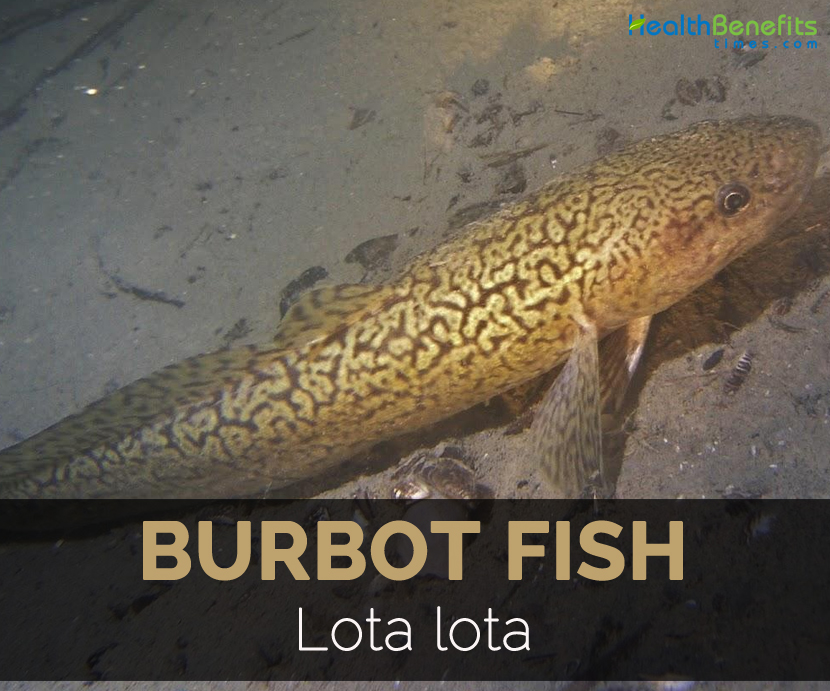| Burbot Fish Quick Facts | |
|---|---|
| Name: | Burbot Fish |
| Scientific Name: | Lota lota |
| Origin | Native to the cold fresh waters of the Nearctic and Palearctic regions found between 40 and 70 degrees North latitudes. |
| Colors | Yellow, light tan to brown with a pattern of dark brown or black |
| Shapes | Elongated and laterally compressed |
| Flesh colors | White |
| Calories | 104 Kcal./cup |
| Major nutrients | Isoleucine 1.027 g (61.42%) Lysine 2.047 g (61.21%) Tryptophan 0.249 g (56.59%) Threonine 0.976 g (55.45%) Valine 1.147 g (54.31%) |
Burbot has color from yellow-brown to brown or even dark olive having black mottling or blotching that provides camouflage appearance. The pectoral fins and underbelly are pale to white. It has short dorsal fin and followed by long second dorsal fin about 6 times length of first and joined to rounded caudal fin. It has 67 to 96 soft dorsal rays with 58 to 79 soft anal rays. It resembles eel more than freshwater fish. It has slimy skin and small scales. Burbot grows 1.5 m in length and weighs 60 lbs in other areas of world. In Minnesota, it is under 8 lbs. or less than 28 inches in length. Burbot is featurized by single barbell that is located on the chin. It has cavernous and extensible mouth with thousands of sharp and small teeth like bass or catfish.
Reproduction
The breeding occurs once per year in the winter. It migrates to smaller stream or shallow water in order to spawn. Individually, Burbot moves to the spawning areas and males arrive before females. During the night spawning occurs when individuals form globular mass. Each fish are towards the center and release sperm or eggs. Spawning takes place in water, laying eggs in shallow water that hatches during spring. Usually reproduction occurs in pairs or sometimes in hundreds or dozens in shallow water over sand and gravel bottoms. After the eggs and sperm are released, the fish thrash about scattering eggs that falls to bottom later. A female could lay upto 1 million eggs that depend on her size. For 4 to 5 weeks, embryos develop in cold water hatch at the tiny size of .15 inches.
Eggs
An average fecundity ranges eggs from 700,000 to 800,000. Eggs are spherical in shape and is amber, yellow and orange in color. Usually eggs hatch in 2 to 4 months.
Habitat
Burbot lives in large lakes, cold rivers and reservoirs generally preferring freshwater habitats but does well in brackish environments for spawning. Burbot can live in Lake Superior at depths below 300 m (980 ft). Typically, they are found in colder water below thermocline during summer. They could tolerate cluster of sand, mud, rubble, silt, boulder and gravel for feeding. They are active crepuscular hunters. During winter months, its population is adfluvial and they migrate to near shore reefs or shoals to spawn favoring spawning grounds of sand or gravel.
Predators
Many fish such as yellow perch, smallmouth bass, lake trout, smelt and muskie prey young burbots. Humans are also regarded as a predator.
How to Eat
- It is used as a source of oil.
- Liver is eaten either canned or smoked.
- It is also processed into fish meal.
- The steamed chunks of meat are dipped in drawn butter.
Precautions
- Consume it in moderate amounts.
- Pregnant women should take an advice from the doctor or health practitioner.
- Avoid the consumption by the children.
- Some people might get an allergic reaction.
Other Facts
- Burbot have been used for oil, fish meal and food for animals which are raised for furs.
- It resembles as a cross between eel and bullhead.
- It has an eye-catching single chin barbell.
- It is usually found in lakes or also streams with cool water and lots of hiding places.
- In North America, it is the only freshwater representative of cod family Gadidae.
- It is scaleless but has small and almost microscopic scales.
- Burbot fish could reach the age of 20 years or more.
- In Alaska, it is the only freshwater fish which spawns in winter under ice.
- The state record made by burbot is 24 lbs 12 oz which is caught in 1976 from Lake Louise.
References:
https://www.itis.gov/servlet/SingleRpt/SingleRpt?search_topic=TSN&search_value=164725#null
http://www.dec.ny.gov/docs/administration_pdf/0612meetburbot.pdf
http://www.biokids.umich.edu/critters/Lota_lota/
Comments
comments
